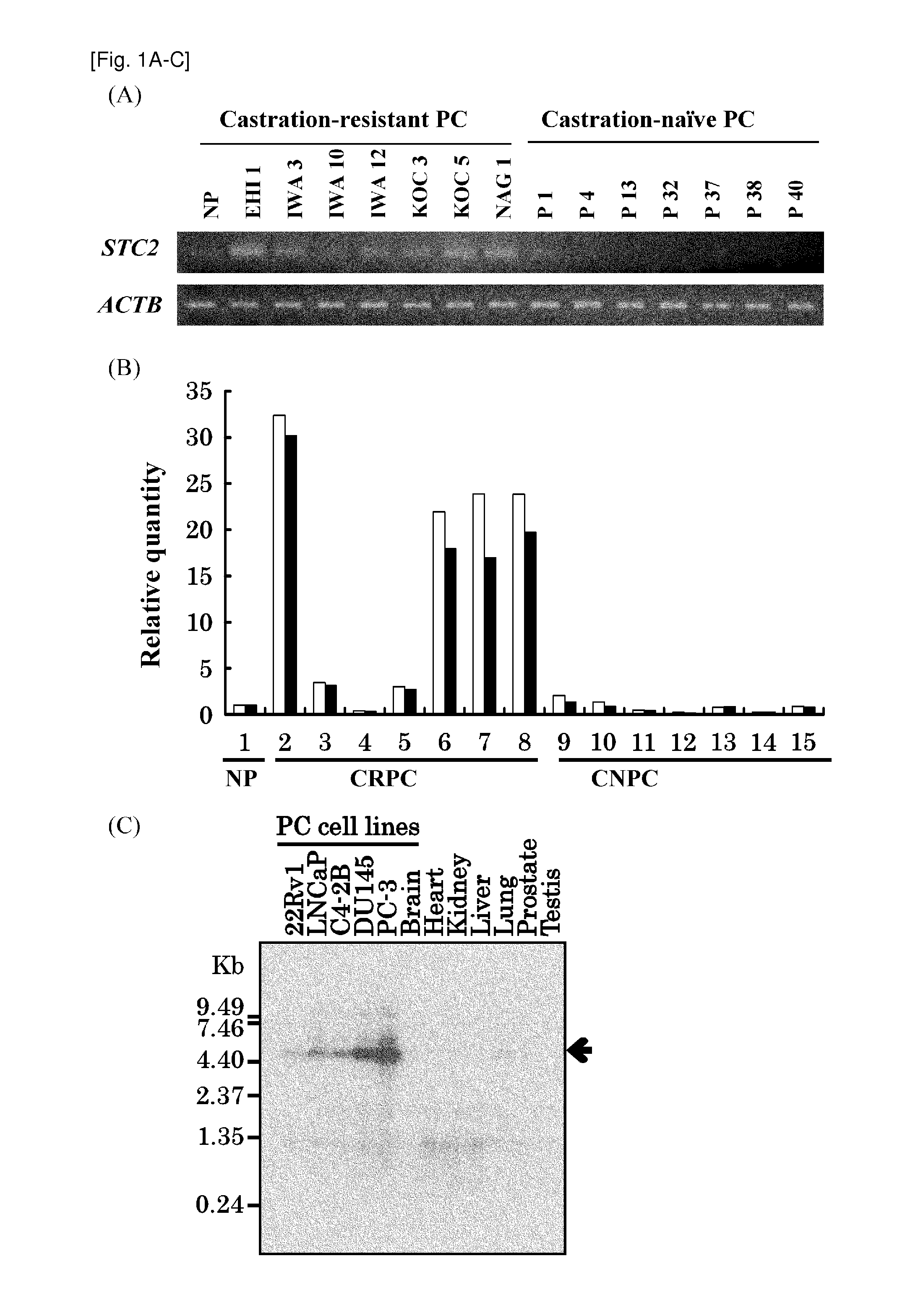Methods for diagnosing or treating prostate cancer
a prostate cancer and cancer technology, applied in the field of biological science, can solve the problems of poor prognosis, inability to identify genes useful for diagnosing and treating crpc, and death of pc patients, so as to reduce the symptoms of pc, reduce the expression level, and reduce the effect of p
- Summary
- Abstract
- Description
- Claims
- Application Information
AI Technical Summary
Benefits of technology
Problems solved by technology
Method used
Image
Examples
example 1
General Methods
[0301]1. Cell Lines
[0302]Human PC cell lines LNCaP, 22Rv1, DU-145, and PC-3 were obtained from American Type Culture Collection (ATCC, Rockville, Md.). LNCaP derived androgen-independent prostate cancer cell line C4-2B was purchased from ViroMed Laboratories (Minnetonka, Minn., USA). All of the cell lines were cultured as monolayers in the following medium: DMEM (Sigma-Aldrich) for 22Rv1, LNCaP, C4-2B and DU-145; and F-12 (GIBCO) for PC-3 with 10% fetal bovine serum and 1% antibiotic / antimycotic solution (Sigma-Aldrich). Cells were maintained in incubators containing humidified air with 5% CO2 at 37 degrees C.
[0303]2. Semi-Quantitative RT-PCR
[0304]Purification of PC cells and normal prostatic epithelial cells from frozen PC tissues was described previously (Tamura K, et al., Cancer Res 2007, 67, 5117-5125). Total RNA was extracted using RNeasy Kit (QIAGEN, Valencia, Calif.) according to manufacturer's instruction, treated with DNase I (Roche Diagnostic, Mannheim, Germ...
example 2
STC2 Over Expression in CRPC Cells
[0319]The genome-wide expression profiles of CRPC cells and CNPC cells purified from clinical PC tissues was previously reported (Tamura K, et al., Cancer Res 2007, 67, 5117-5125). Among a number of genes shown to be trans-activated in CRPC cells compared normal prostate epithelial cells (NP), STC2 was focused in this invention. Semi-quantitative RT-PCR (FIG. 1A) and real-time quantitative RT-PCR (FIG. 1B) confirmed the elevated expression of STC2 in 6 out of the 7 clinical CRPC cells, comparing with CNPC cells and NP cells. Northern blot analysis using five PC cell lines and normal adult tissues confirmed the elevated expression of STC2 in all of PC cell lines, compared with normal prostate and adult vital organs including brain, adult, kidney, liver, and liver (FIG. 1C). Multiple tissue northern (MTN) blot analysis also revealed no or very limited expression of STC2 in most normal adult organs, and low expression was observed only in normal pancre...
example 3
Immunohistochemical Analysis in Clinical PC Tissues
[0320]To validate the over-expression of STC2 protein in CRPC cells, immunohistochemical analysis on clinical PC tissues was performed by using monoclonal antibody specific to human STC2. As shown in FIG. 1E, strong immunochemical signal for STC2 was detected predominantly in the cytoplasm of cancer cells exceptionally in CRPC cases examined. 6 of 9 CRPCs examined showed strong immunoreactivity to anti-STC2 antibody and one CNPC with Gleason score 10 also showed strong immunoreactivity (FIG. 1F), while CNPC with Gleason score 7 did not show any immunoreactivity to anti-STC2 antibody (FIG. 1G). Adjacent normal prostatic epithelium in the same patient revealed very weak or no signal for STC2. Hormone ablation therapy is usually ineffective for PCs with Gleason score 10, which progress highly aggressively, and these findings demonstrated that STC2 was expressed specifically in CRPCs and highly aggressively PCs.
[0321]To further investig...
PUM
| Property | Measurement | Unit |
|---|---|---|
| Electrical resistance | aaaaa | aaaaa |
| Biological properties | aaaaa | aaaaa |
Abstract
Description
Claims
Application Information
 Login to View More
Login to View More - R&D
- Intellectual Property
- Life Sciences
- Materials
- Tech Scout
- Unparalleled Data Quality
- Higher Quality Content
- 60% Fewer Hallucinations
Browse by: Latest US Patents, China's latest patents, Technical Efficacy Thesaurus, Application Domain, Technology Topic, Popular Technical Reports.
© 2025 PatSnap. All rights reserved.Legal|Privacy policy|Modern Slavery Act Transparency Statement|Sitemap|About US| Contact US: help@patsnap.com



